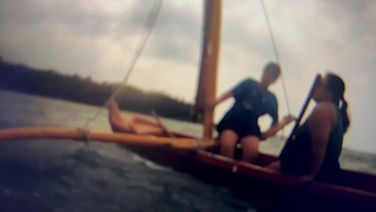
Huli: Over Turned Canoe

In his book, The Hawaiian Canoe, Tommy Holems quotes I‘i: “Many have perished because of ignorance and because they did not know how to set [right] canoes that had met with an accident.” In such circumstances, there were, however, “rules for refloating a canoe that had overturned at sea, thereby saving it and its occupants from destruction.”
.jpg)
If in calm seas and low wind, an overturned canoe was simply righted by the occupants standing on the muku ends of the ‘iako, then reaching over the overturned hull, grab hold of the lapu’una section of the ‘iako. They would then pull the ‘iako, lifting the ama up out of the water and flipping back over. The flooded hull was then bailed out.
If the occupants of the canoe were in somewhat rougher sea conditions, they would right the overturned hull as described above and then position the flooded canoe to point the bow into the oncoming swells. The occupants would then gather at the stern end of the canoe, stand on the stern Kupe and push the stern of the canoe as deep into the water as possible, then in time with an oncoming swell, kick the canoe forward. The inclined hull being lifted by the oncoming swell would cause a significant amount of water to flow out of the swamped hull and allow for some freeboard where the remaining water could be bailed out.
Another method would be to sink the ama of the overturned canoe as deep as possible, then with ropes tied the Kapu’ai section of the ama pull the ama under the overturned hull. The submerged ama would raise the hull enough to allow a significant amount of water to flow out of the hull so when the ama rose up again the righting hull. Enough freeboard was obtained to allow the hull to be bailed out.
If the canoe was equipped with a sail, the sail would prevent the canoe from fully flipping over. If acted open quickly enough, the occupants of the canoe would pull the ama back down into the water and then bail the partially swamped hull out.
.jpg)
.jpg)
If the sail was allowed to sink or become filled with water the entire sail rig would have to be removed and one of the righting processes described above used to right the canoe.
In some instances, Lona, or rollers used to beach a canoe, would be placed under a swamped hull to add additional flotation increasing the freeboard of a swamped canoe so it could be bailed out.
When a canoe did overturn, one occupant of the canoe would be placed in charge of holding any loose paddles and floating baggage while the other occupants righted the overturned hull. Bailing would begin with occupants holding onto the gunwales of the canoe but not entering the hull. Once at least one-third of the hull was bailed out the lightest crew member would enter the swamped hull and continue to bail until the swamped hull was largely free of water.
We have not found any references to the traditional methods of righting an overturned double-hull canoe. In our experience, we have had one hull become swamped but never overturned. In this instance, flotation devices were placed under the swamped hull to raise the freeboard and the swamped hull was bailed out.